A Viscous Boundary Layer Mesh Adaptation Method and Its Application in High-Angle-of-Attack Separated Flows
Abstract
1. Introduction
2. Numerical Simulation and Adjoint-Based Mesh Adaptation
2.1. Flow Solver and Governing Equations
2.2. Adjoint-Based Error Estimation and Mesh Adaptation Methodology
3. Viscous Boundary Layer Mesh Adaptation Method
3.1. Mesh Refinement and Coarsening Methods
- (1)
- To prevent excessive volume ratios between adjacent cells, the level difference between co-faced mesh elements is limited to no more than 1.
- (2)
- When co-faced elements are assigned conflicting adaptation operations (e.g., refinement vs. coarsening) that would result in a level difference exceeding 1, refinement takes precedence. For instance, if element {2} is marked for coarsening and element {3} for refinement in Figure 7, the refinement of element {3} is prioritized.
3.2. Adjoint-Based Mesh Adaptation Criterion
3.3. Polyhedral Grid Conversion Method for Boundary Layers
3.4. Refinement and Coarsening Methods for Polyhedral Grids in Adaptive Iteration
3.5. Surface Mesh Projection and Spatial Compatibility Method
4. Numerical Experiments
4.1. Low-Speed High-Angle-of-Attack Simulation of NACA0012 Airfoil
4.1.1. Model and Mesh Configuration
4.1.2. Results from Initial Mesh Computation
4.1.3. Adjoint-Based Mesh Adaptation Optimization
4.2. High-Angle-of-Attack Simulation of the CHN-F1 Low-Aspect-Ratio Flying Wing
4.2.1. Model and Mesh Configuration
4.2.2. Results of Initial Mesh
4.2.3. Error Estimation Based on Adjoint Theory
4.2.4. Mesh Adaptation Based on Adjoint Error Estimation
5. Conclusions
- (1)
- An innovative polyhedral mesh conversion method effectively resolves topological constraints in boundary layer adaptation. This approach enables local, anisotropic refinement/coarsening of layered elements (prisms/hexahedra) by converting hanging-node cells into polyhedra, eliminating the “through-cut” partitioning and directional limitations inherent in traditional methods, thereby achieving precise resolution of critical boundary layer flow features.
- (2)
- A robust processing framework for viscous boundary layer adaptation is established, integrating adjoint-based error estimation, polyhedral conversion, Coons surface-based projection, and distance-function mesh deformation. This ensures accurate geometric preservation and mesh quality compatibility during adaptation, significantly enhancing the applicability of mesh adaptation techniques for complex viscous flow simulations.
- (3)
- Numerical experiments demonstrate substantial improvements in aerodynamic prediction accuracy, particularly in complex scenarios like high-angle-of-attack separated flows. For the NACA0012 case, adjoint-based adaptation reduced lift coefficient error near stall from 4.21% to 0.30% by optimizing mesh distribution around leading-edge pressure peaks and trailing-edge separation zones. For the CHN-F1 flying wing, the method automatically identified and refined lift-error-sensitive regions like wingtip vortex cores, clearly resolving vortex formation, development, and breakdown processes, significantly improving stall characteristic predictions.
Author Contributions
Funding
Data Availability Statement
Conflicts of Interest
References
- Morgado, F.; Garbacz, C.; Fossati, M. Impact of anisotropic mesh adaptation on the aerothermodynamics of atmospheric reentry. AIAA J. 2022, 60, 3973–3989. [Google Scholar] [CrossRef]
- Colombo, S.; Re, B. An ALE residual distribution scheme for the unsteady Euler equations over triangular grids with local mesh adaptation. Comput. Fluids 2022, 239, 105414. [Google Scholar] [CrossRef]
- Chawner, J.R.; Taylor, N.J. Progress in Geometry Modeling and Mesh Generation Toward the CFD Vision 2030. In Proceedings of the AIAA Aviation 2019 Forum, Dallas, TX, USA, 17–21 June 2019. AIAA-2019-2945. [Google Scholar]
- Galindo, J.; Serrano, J.R.; Dolz, V.; Iljaszewicz, P. Impact of Mesh Resolution and Temperature Effects in Jet Ejector CFD Calculations. Appl. Sci. 2025, 15, 3880. [Google Scholar] [CrossRef]
- Cottrell, J.A.; Hughes, T.J.R.; Bazilevs, Y. Isogeometric Analysis: Toward Integration of CAD and FEA; John Wiley & Sons, Ltd.: Hoboken, NJ, USA, 2009. [Google Scholar]
- Luo, C.; Zhou, D.; Meng, S.; Bi, L.; Wang, W.; Yuan, X.; Tang, Z. A Novel Cell-Based Adaptive Cartesian Grid Approach for Complex Flow Simulations. Appl. Sci. 2024, 14, 3692. [Google Scholar] [CrossRef]
- Clerici, F.; Spalart, P.R.; Alauzet, F. Turbulence driven goal-oriented anisotropic mesh adaptation for RANS simulations in aerodynamics. J. Comput. Phys. 2024, 514, 113191. [Google Scholar] [CrossRef]
- Slotnick, J.P.; Khodadoust, A.; Alonso, J.; Darmofal, D.; Gropp, W.; Lurie, E.; Mavriplis, D.J. CFD Vision 2030 Study: A Path to Revolutionary Computational Aerosciences; NASA/CR-2014-218178; NASA: Pasadena, CA, USA, 2014. [Google Scholar]
- Michal, T.; Babcock, D.; Kamenetskiy, D.; Krakos, J.; Mani, M.; Glasby, R.; Erwin, E.; Stefanski, D.L. Comparison of Fixed and Adaptive Unstructured Grid Results for Drag Prediction Workshop 6. J. Aircr. 2018, 55, 1420–1432. [Google Scholar] [CrossRef]
- Tinoco, E.N.; Brodersen, O.P.; Keye, S.; Laflin, K.R.; Feltrop, E.; Vassberg, J.C.; Mani, M.; Rider, B.; Wahls, M.A.; Morrison, J.H.; et al. Summary Data from the Sixth AIAA CFD Drag Prediction Workshop: CRM Cases. J. Aircr. 2018, 55, 1352–1379. [Google Scholar] [CrossRef]
- Balan, A.; Park, M.A.; Wood, S.L.; Anderson, W.K.; Rangarajan, A.; Sanjaya, D.P.; May, G. A review and comparison of error estimators for anisotropic mesh adaptation for flow simulations. Comput. Fluids 2022, 234, 105259. [Google Scholar] [CrossRef]
- Alauzet, F.; Loseille, A.; Olivier, G. Time-accurate multi-scale anisotropic mesh adaptation for unsteady flows in CFD. J. Comput. Phys. 2018, 373, 28–63. [Google Scholar] [CrossRef]
- Baker, T.J. Mesh Generation: Art or Science? Prog. Aerosp. Sci. 2005, 41, 29–63. [Google Scholar] [CrossRef]
- Balan, A.; Park, M.A.; Wood, S.; Anderson, W.K. Verification of Anisotropic Mesh Adaptation for Complex Aerospace Applications. In Proceedings of the AIAA Scitech 2020 Forum, Orlando, FL, USA, 6–10 January 2020. AIAA-2020-0675. [Google Scholar]
- Park, M.A.; Carlson, J. Turbulent Output-Based Anisotropic Adaptation. In Proceedings of the 48th AIAA Aerospace Sciences Meeting Including the New Horizons Forum and Aerospace Exposition, Orlando, FL, USA, 4–7 January 2010. AIAA-2010-168. [Google Scholar]
- Park, M.A.; Lee-Rausch, B.; Rumsey, C. FUN3D and CFL3D Computations for the First High Lift Prediction Workshop. In Proceedings of the 49th AIAA Aerospace Sciences Meeting Including the New Horizons Forum and Aerospace Exposition, Orlando, FL, USA, 4–7 January 2011. AIAA-2011-936. [Google Scholar]
- Chitale, K.C.; Sahni, O.; Shephard, M.S.; Tendulkar, S.; Jansen, K.E. Anisotropic Adaptation for Transonic Flows with Turbulent Boundary Layers. AIAA J. 2015, 53, 367–378. [Google Scholar] [CrossRef]
- Cui, P.; Zhou, G.; Zhang, Y.; Jia, H.; Wu, X.; Ma, M.; Li, H.; Chen, B. Improved delayed detached-eddy investigations on the flow control of the leading-edge flat spoiler of the cavity in the low-aspect-ratio aircraft. Aerospace 2022, 9, 526. [Google Scholar] [CrossRef]
- Zhang, J.; Dai, Z.; Li, R.; Deng, L.; Liu, J.; Zhou, N. Acceleration of a Production-Level Unstructured Grid Finite Volume CFD Code on GPU. Appl. Sci. 2023, 13, 6193. [Google Scholar] [CrossRef]
- Tang, J.; Zhang, J.; Li, B.; Cui, P.; Zhou, N. Parallel algorithms for unstructured hybrid mesh adaptation. Acta Aeronaut. Astronaut. Sin. 2020, 41, 91–100. [Google Scholar]
- Cui, P.; Li, B.; Tang, J.; Chen, J.; Deng, Y. A modified adjoint-based grid adaptation and error correction method for unstructured grid. Mod. Phys. Lett. B 2018, 32, 1840020. [Google Scholar] [CrossRef]
- Dolejsi, V.; Roskovec, F. Goal-oriented anisotropic hp-adaptive discontinuous Galerkin method for the Euler equations. Commun. Appl. Math. Comput. 2022, 4, 143–179. [Google Scholar] [CrossRef]
- Vivarelli, G.; Qin, N.; Shahpar, S.; Radford, D. Sequential feature-based mesh movement and adjoint error-based mesh refinement. Int. J. Numer. Methods Fluids 2021, 93, 249–272. [Google Scholar] [CrossRef]
- Vivarelli, G.; Qin, N.; Shahpar, S. A review of mesh adaptation technology applied to computational fluid dynamics. Fluids 2025, 10, 129. [Google Scholar] [CrossRef]
- Lu, F.; Qi, L.; Jiang, X.; Liu, G.; Liu, Y.; Chen, B.; Pang, Y.; Hu, X. NNW-GridStar: Interactive structured mesh generation software for aircrafts. Adv. Eng. Softw. 2020, 145, 102803. [Google Scholar] [CrossRef]
- Liu, Y.; Hu, Y.; Xie, D.; Zhang, Y.; Chen, J. A lightweight interactive approach for unstructured surface mesh generation. Eng. Comput. 2025, 42, 1942–1961. [Google Scholar] [CrossRef]
- McCroskey, W.J. A Critical Assessment of Wind Tunel Results for the NACA0012 Airfoil; NASA-TM-100019; NASA: Pasadena, CA, USA, 1987. [Google Scholar]
- Cui, P.; Li, H.; Jia, H.; Li, L.; Qin, F.; Wu, X.; Zhang, Y. An improved Harten-Lax-Leer-Einfeldt plus plus scheme for unstructured grid and cell-centred finite-volume method. Phys. Fluids 2025, 37, 076130. [Google Scholar] [CrossRef]
- Su, J.; Huang, Y.; Zhong, Y.; Li, Y. Research on flow characteristics of low-aspect-ratio flying-wing at transonic speed. Acta Aerodyn. Sin. 2015, 33, 307–312. [Google Scholar]
- Li, Y.; Liu, H.; Huang, Y.; Zhong, S.; Su, J. Investigation on the correlation of high-speed force test results of flying-wing calibration model with low-aspect ratio. Acta Aerodyn. Sin. 2016, 34, 107–112. [Google Scholar]
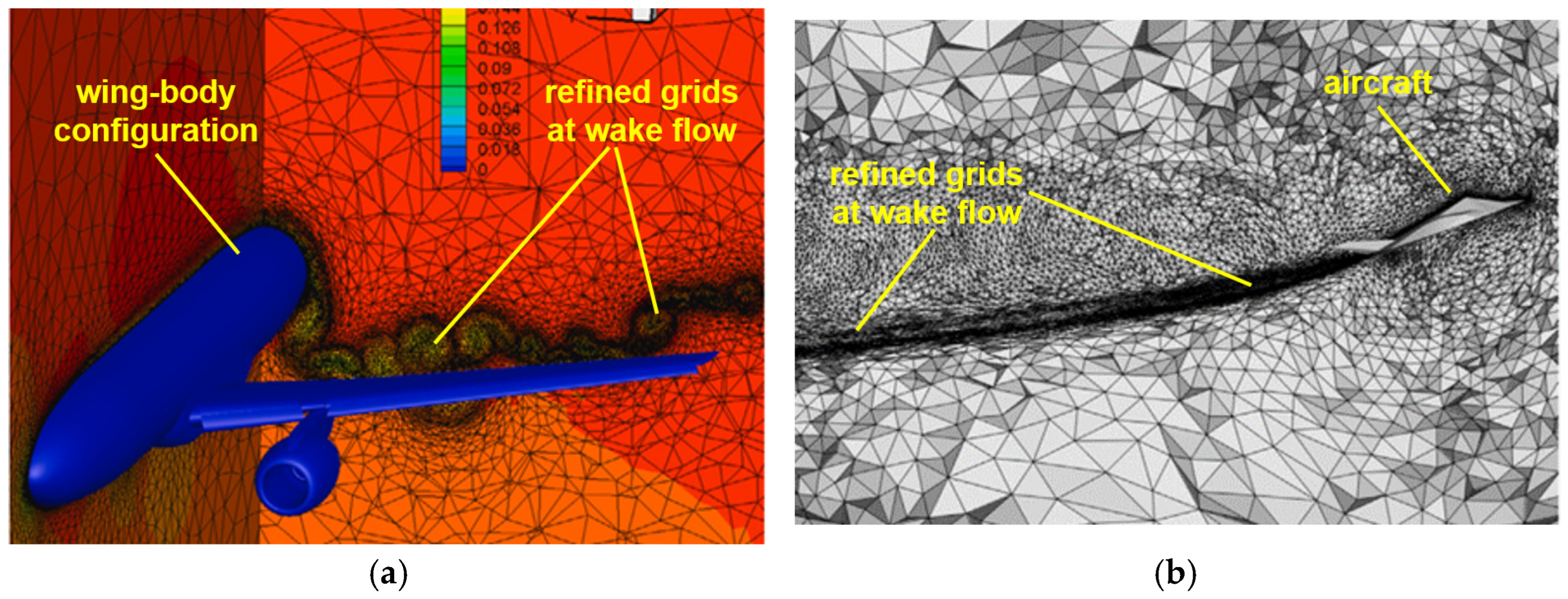



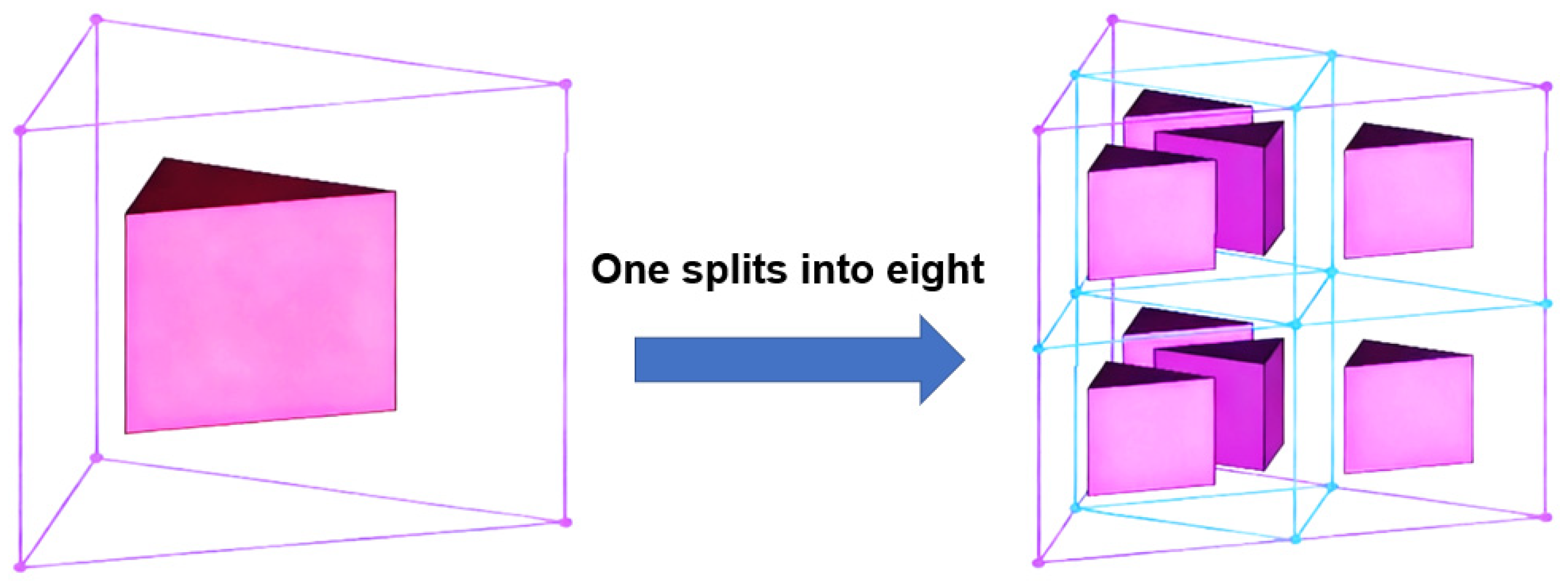
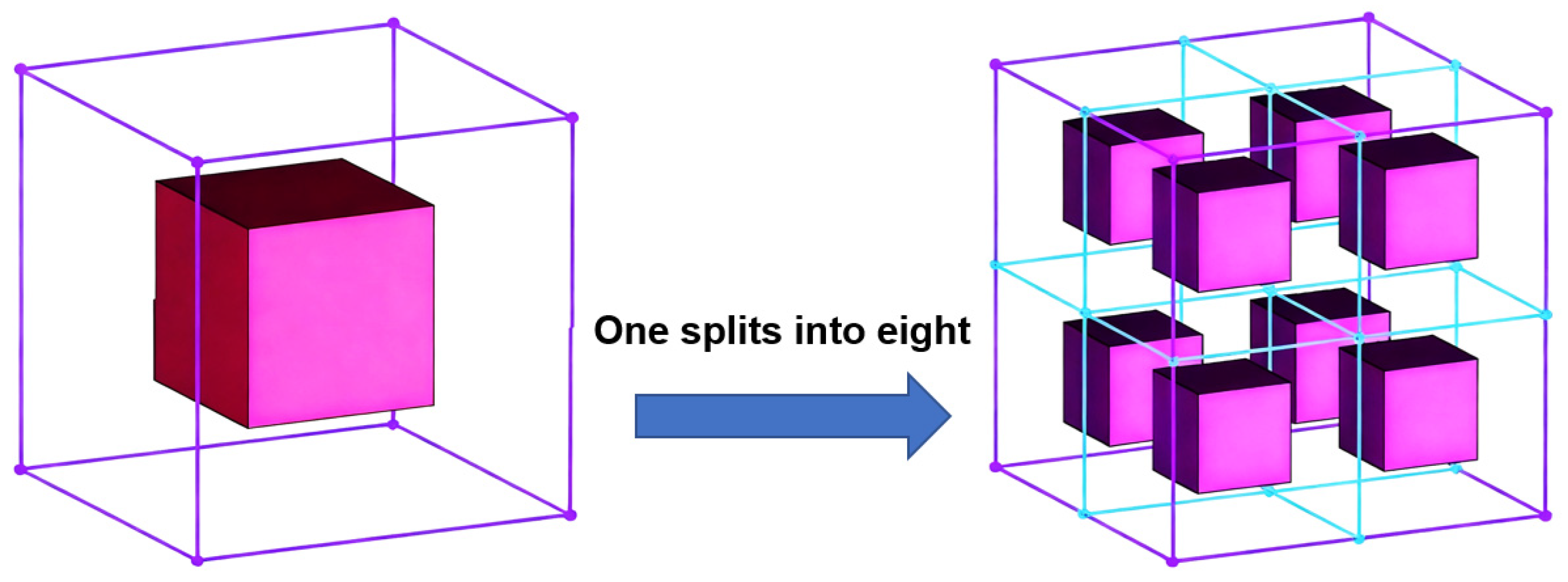
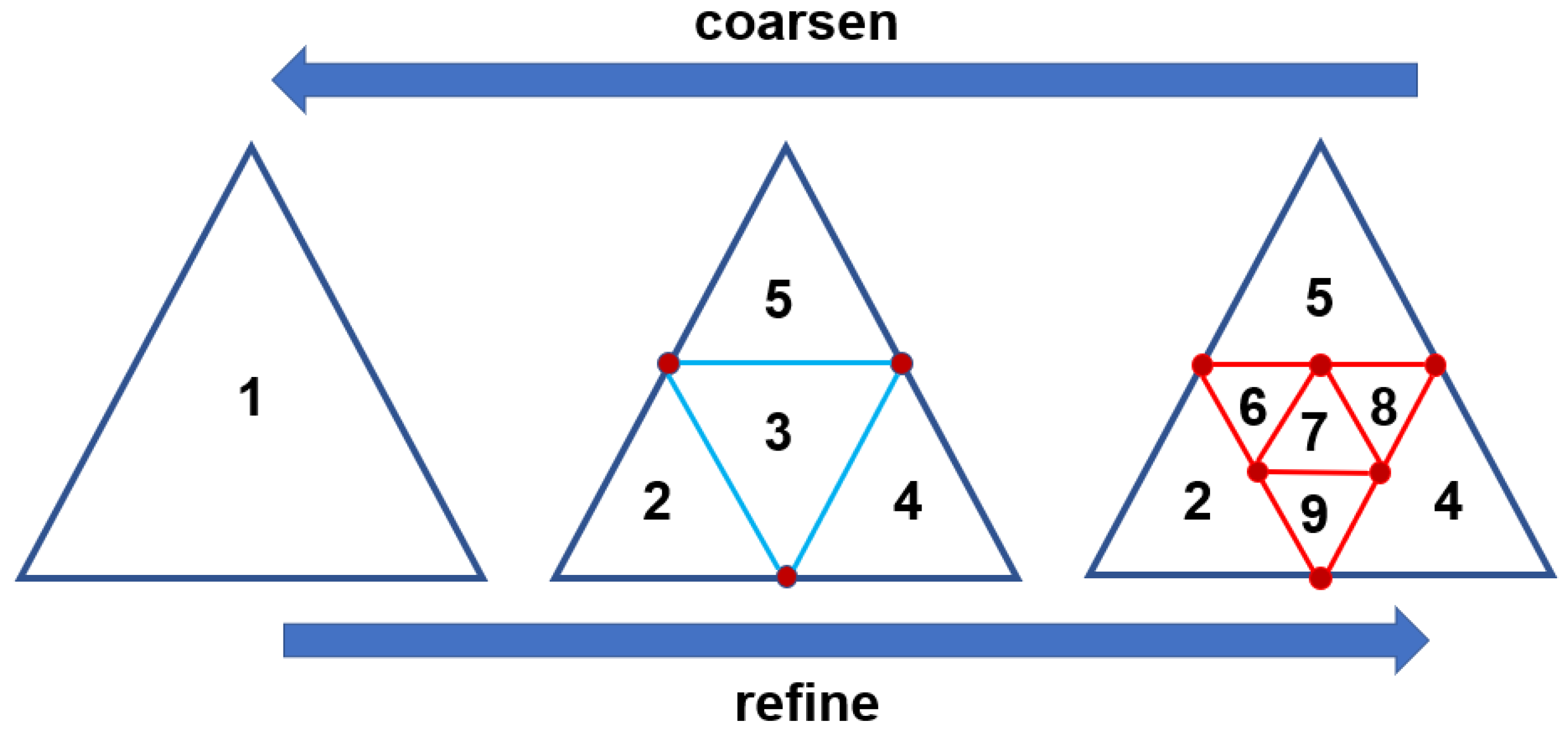

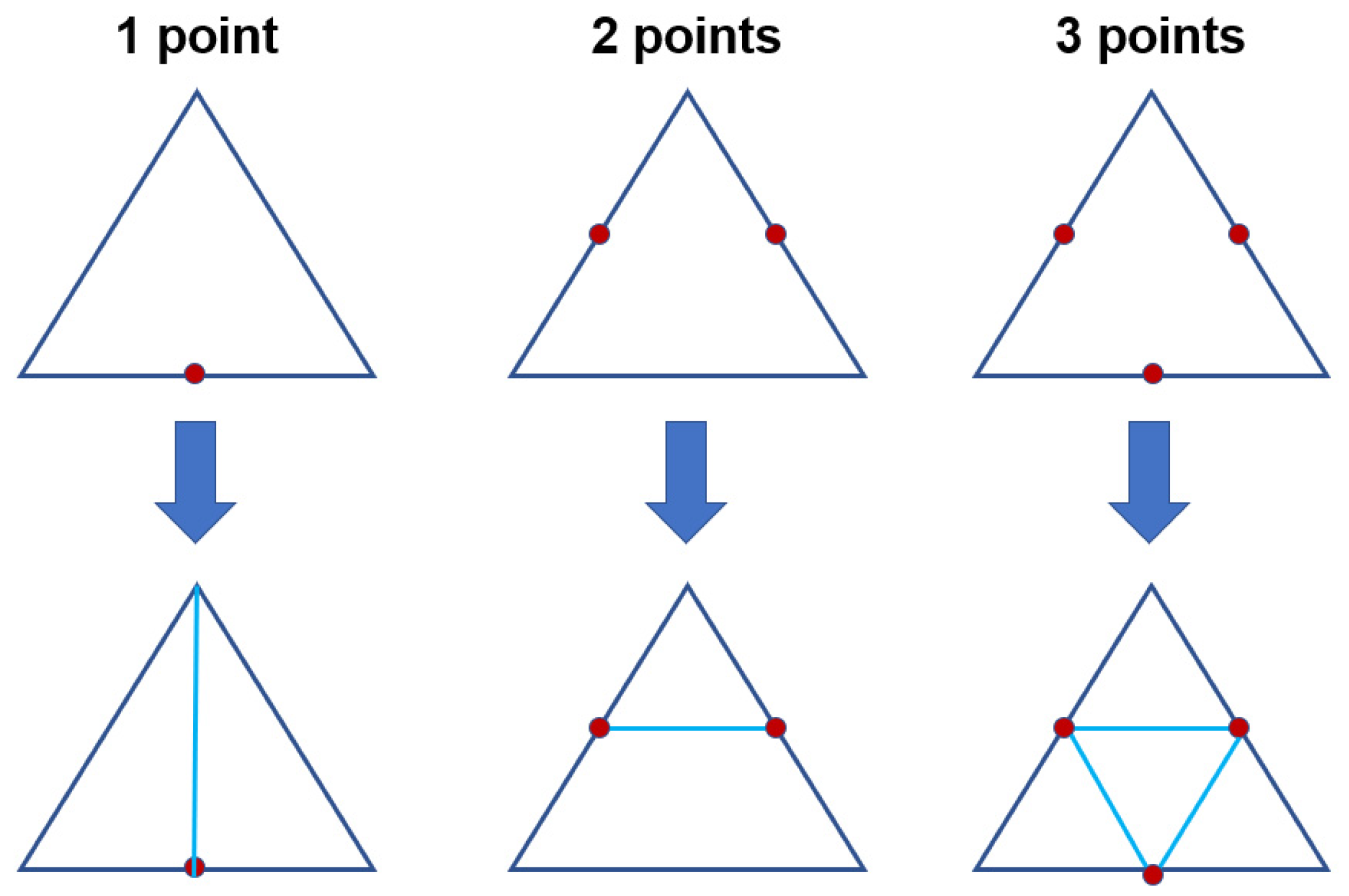


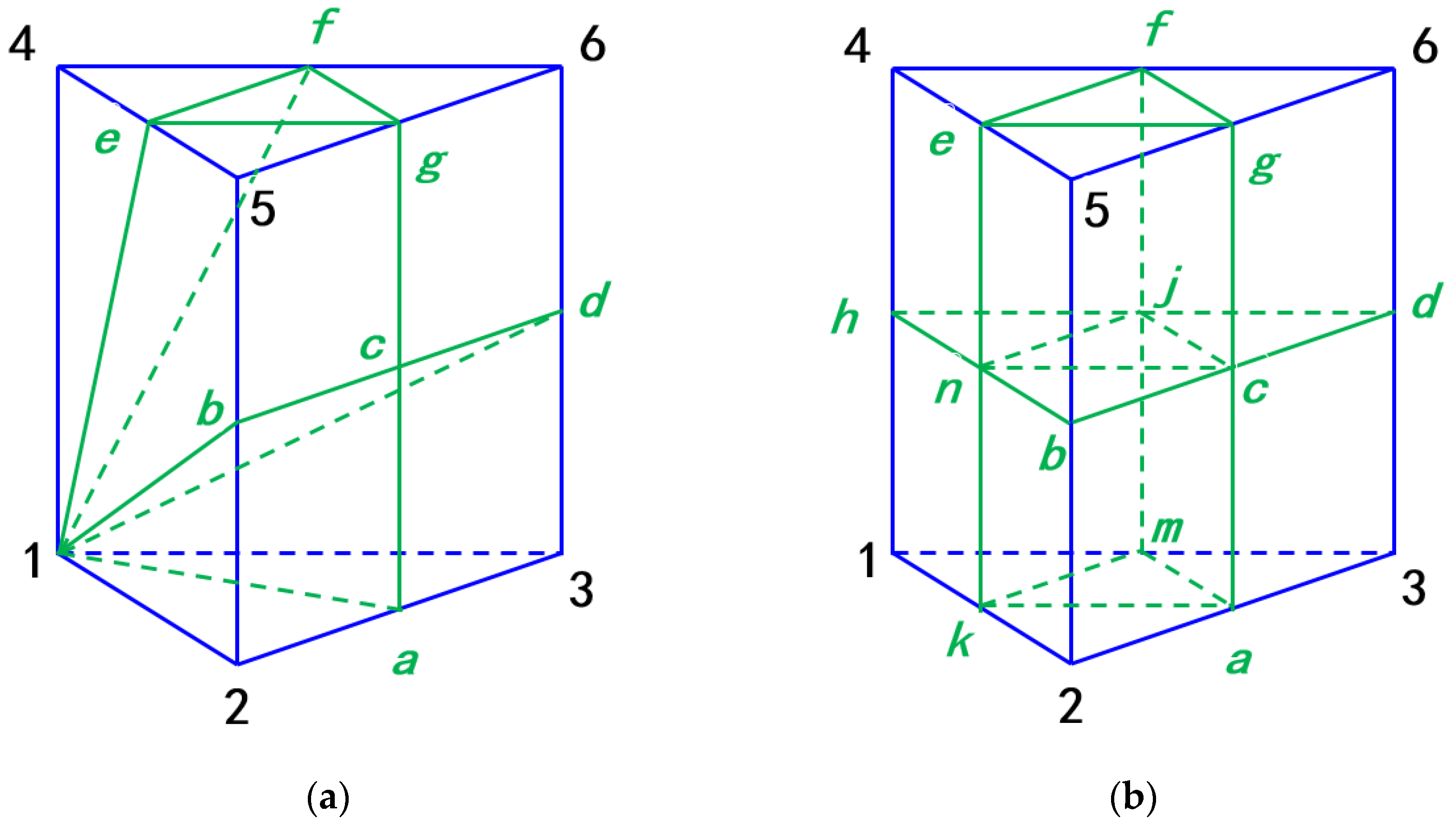



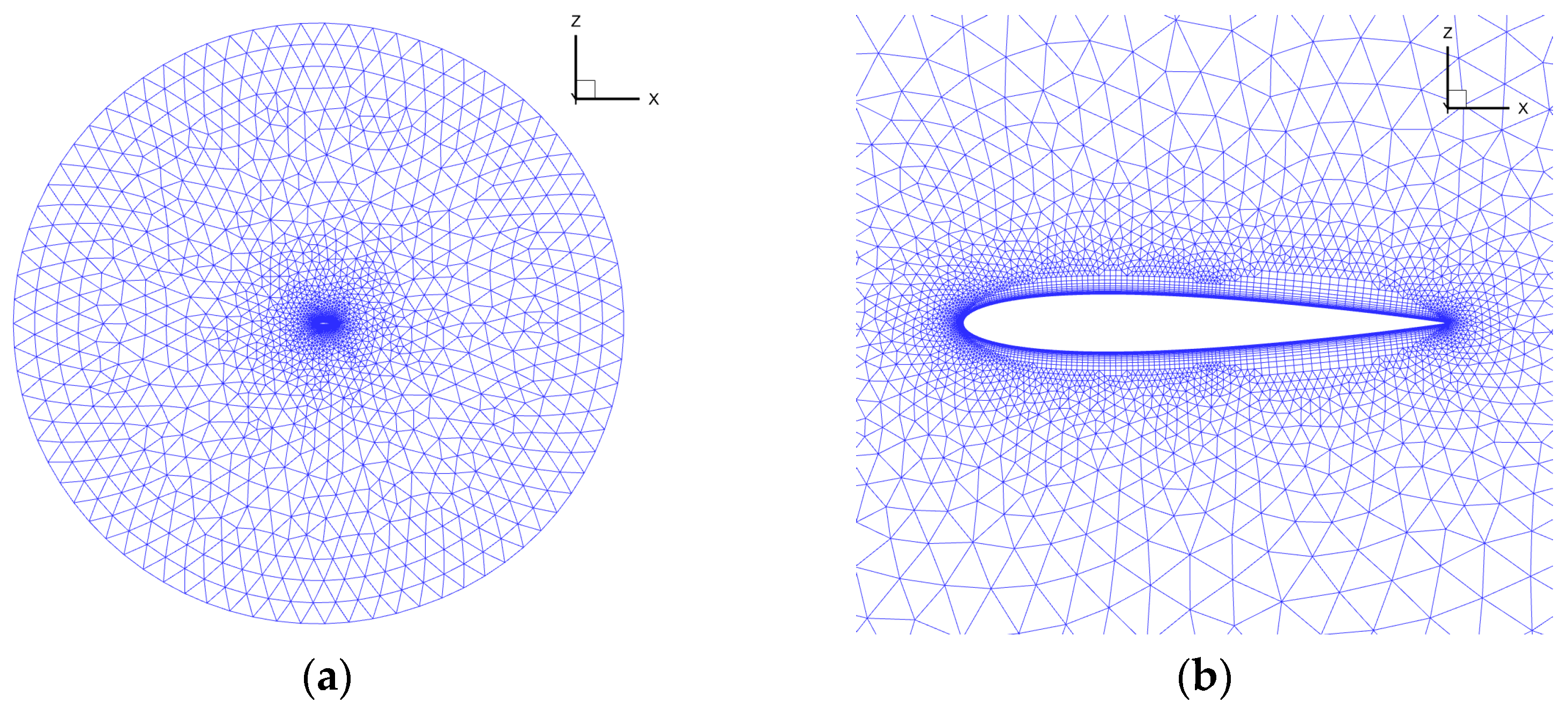
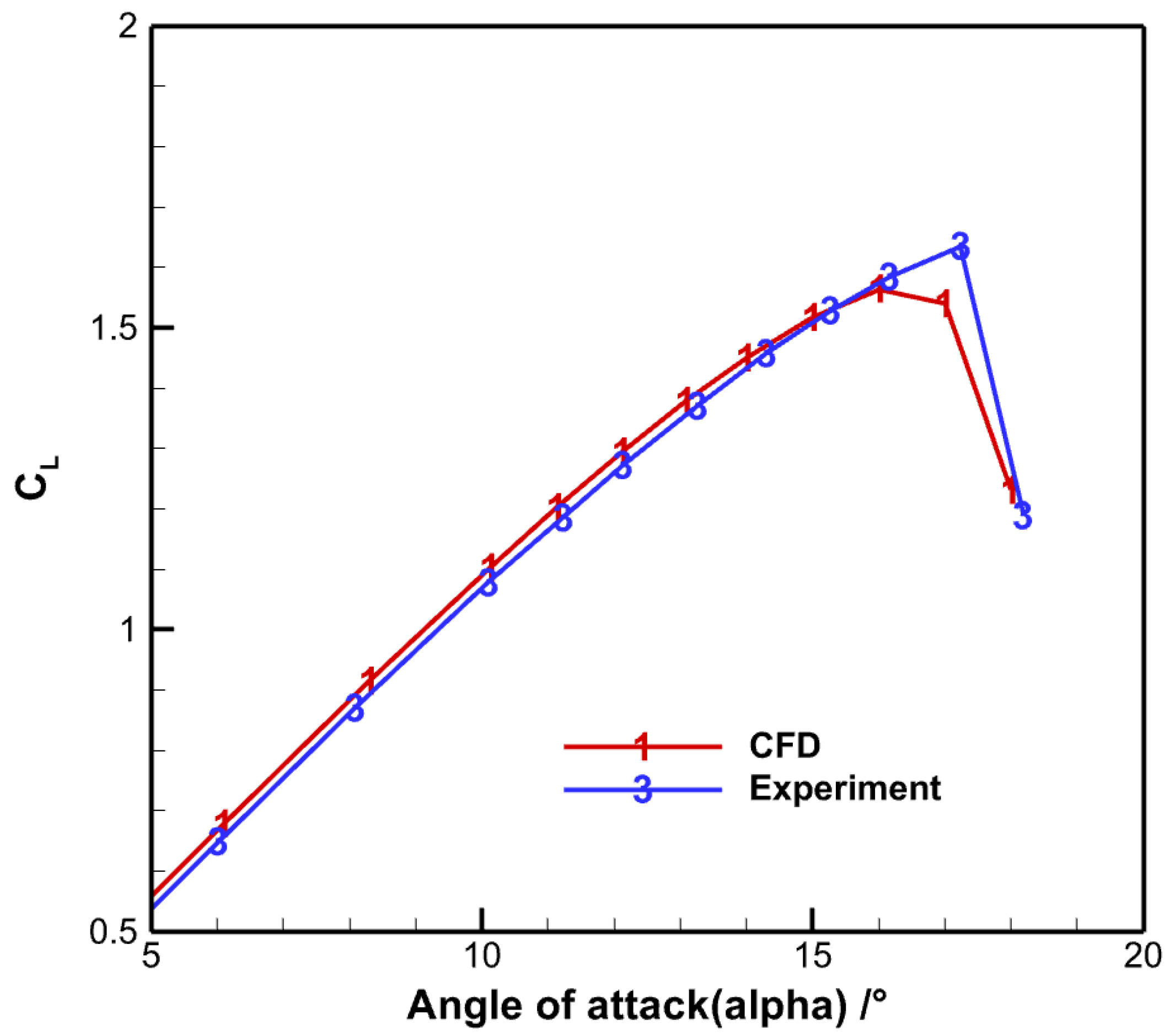
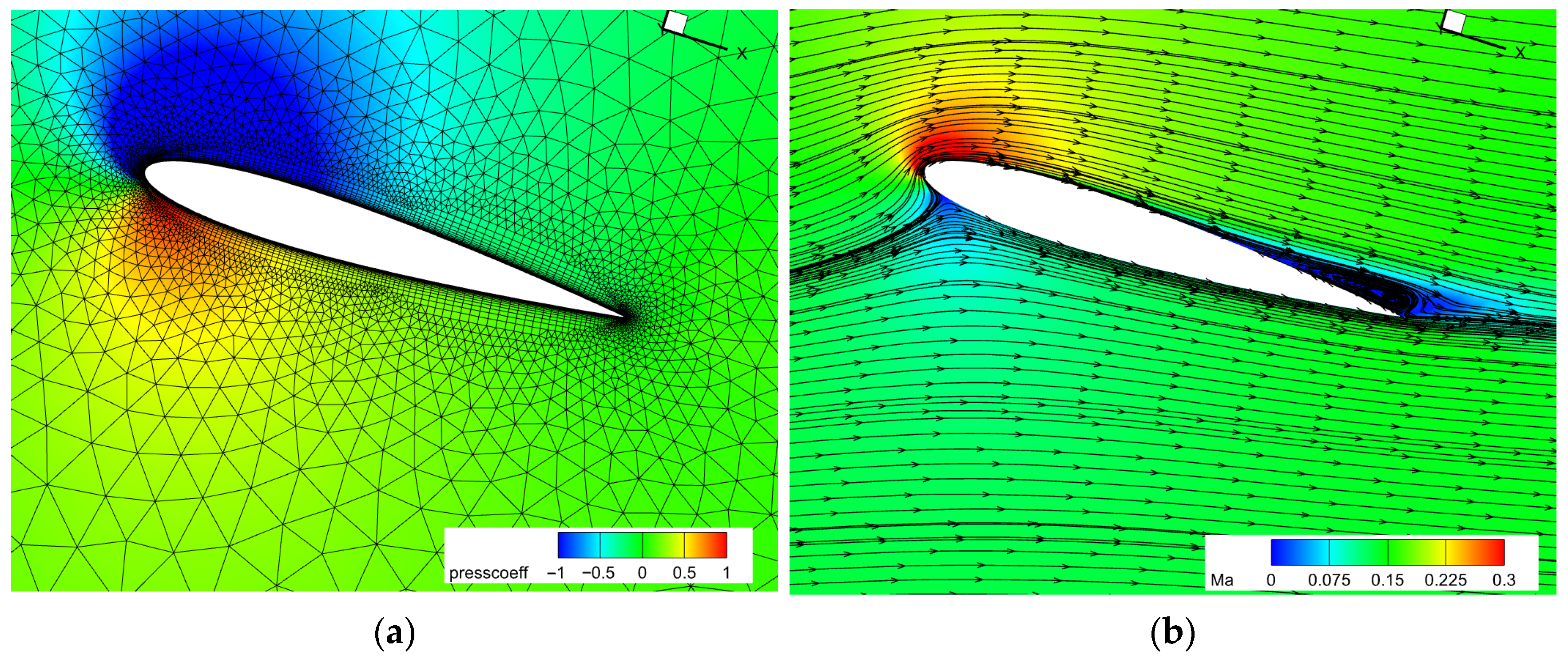

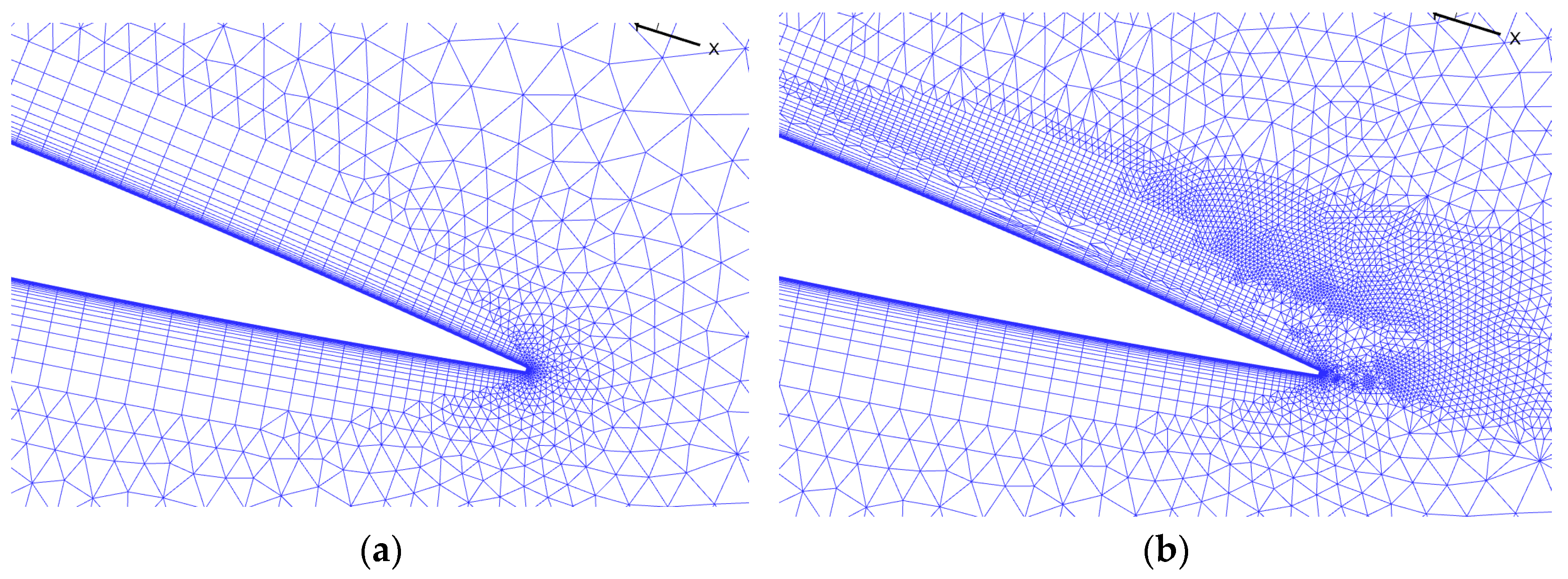
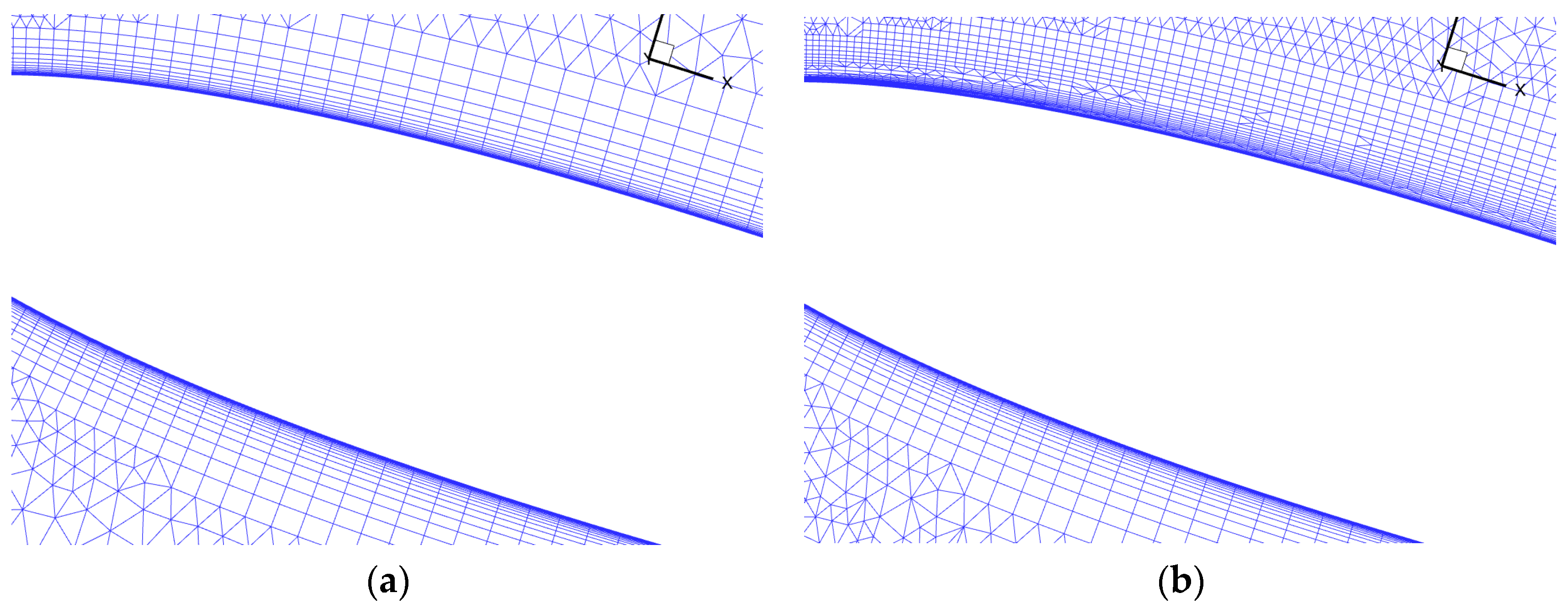
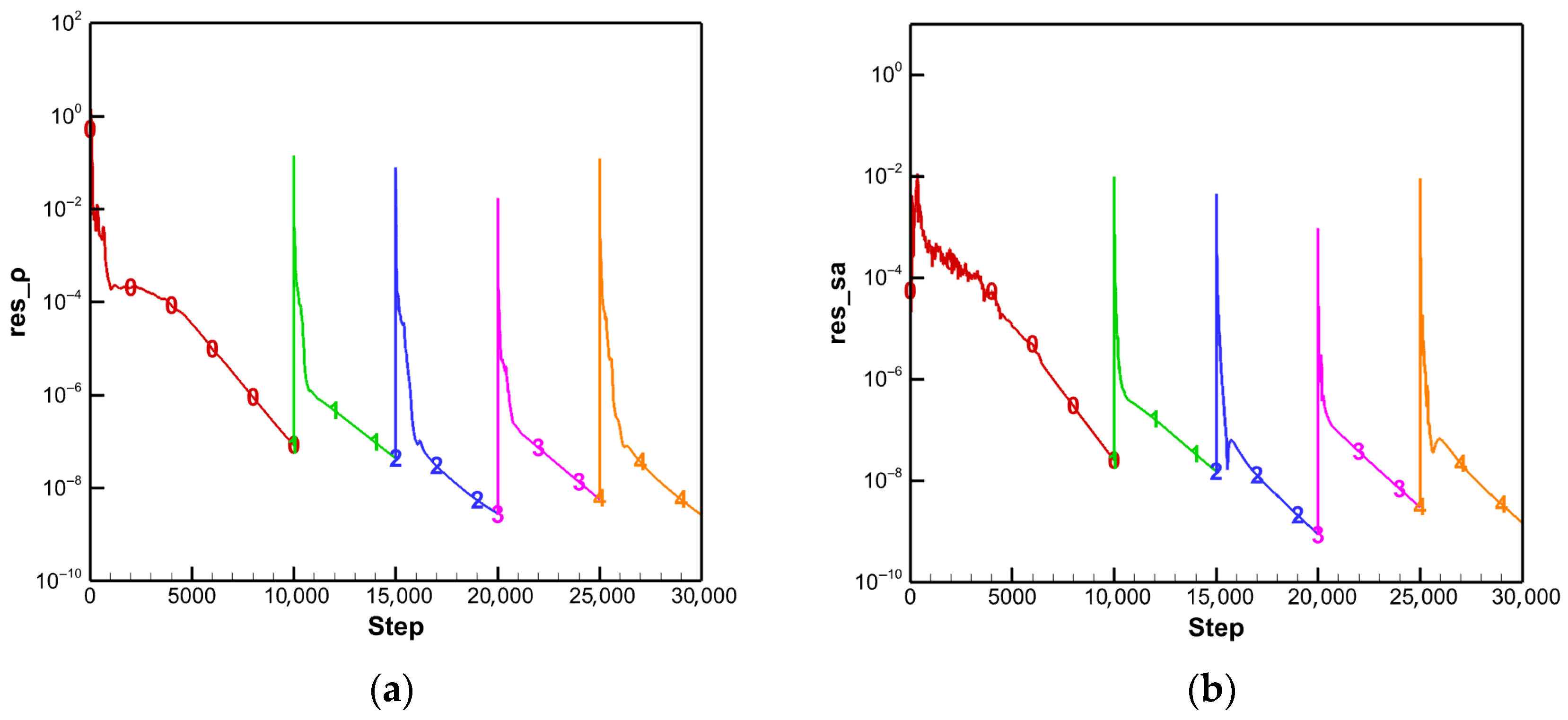

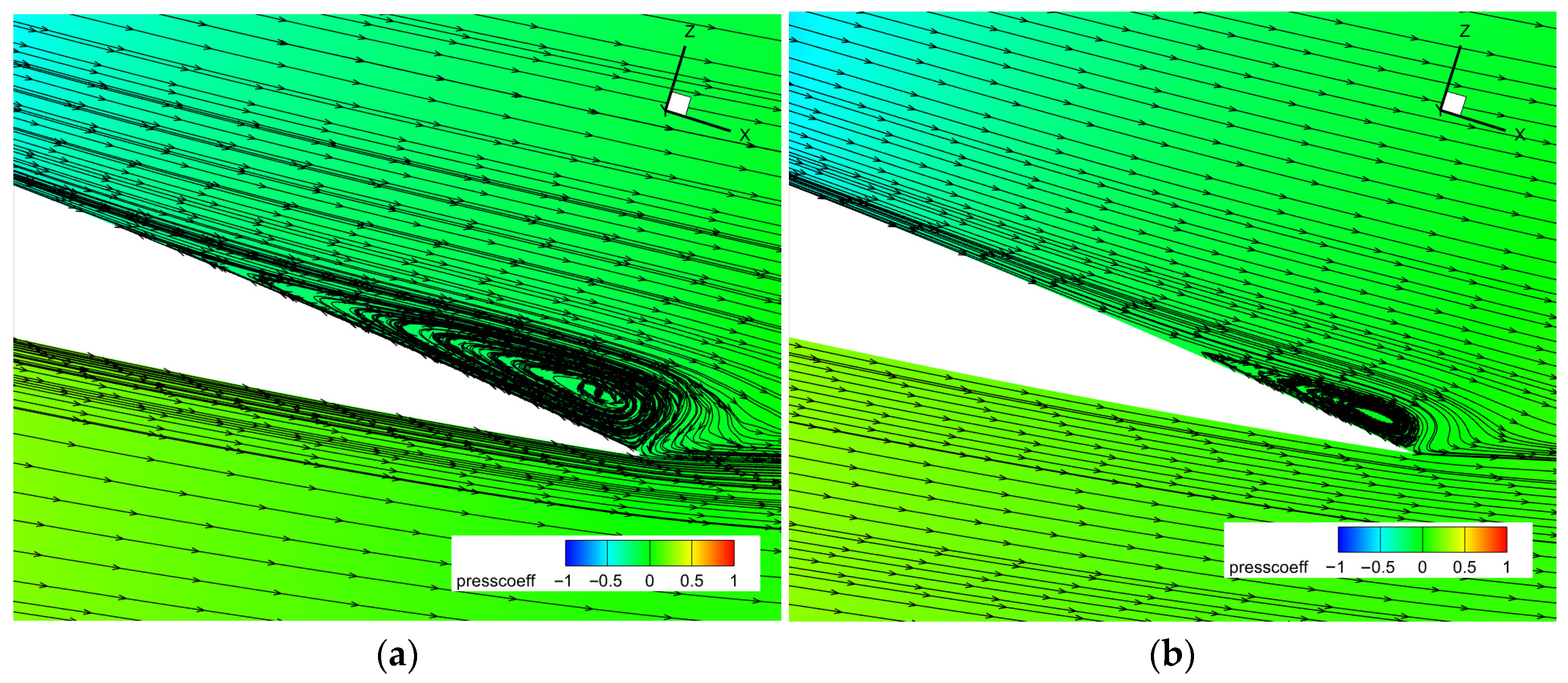

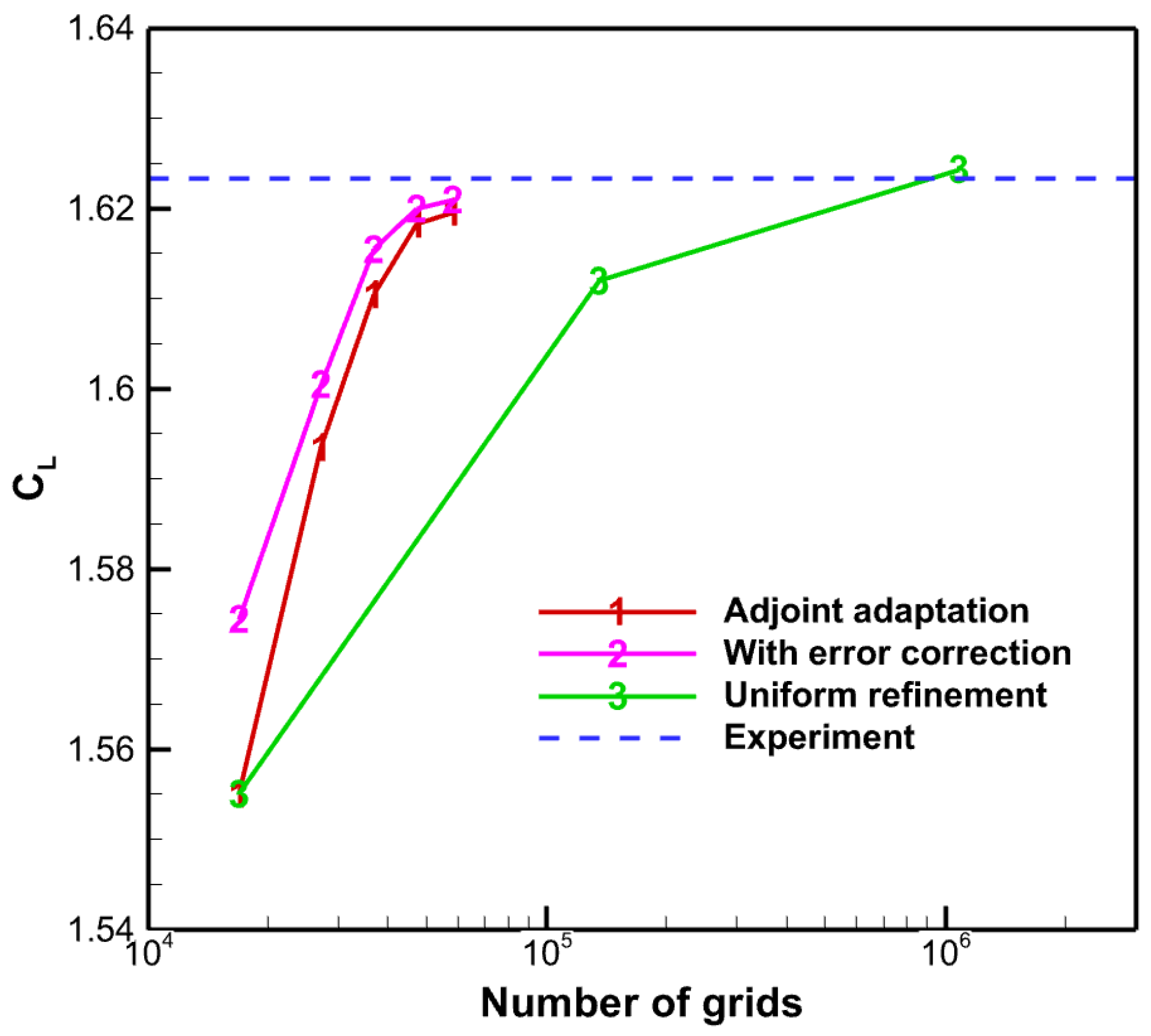


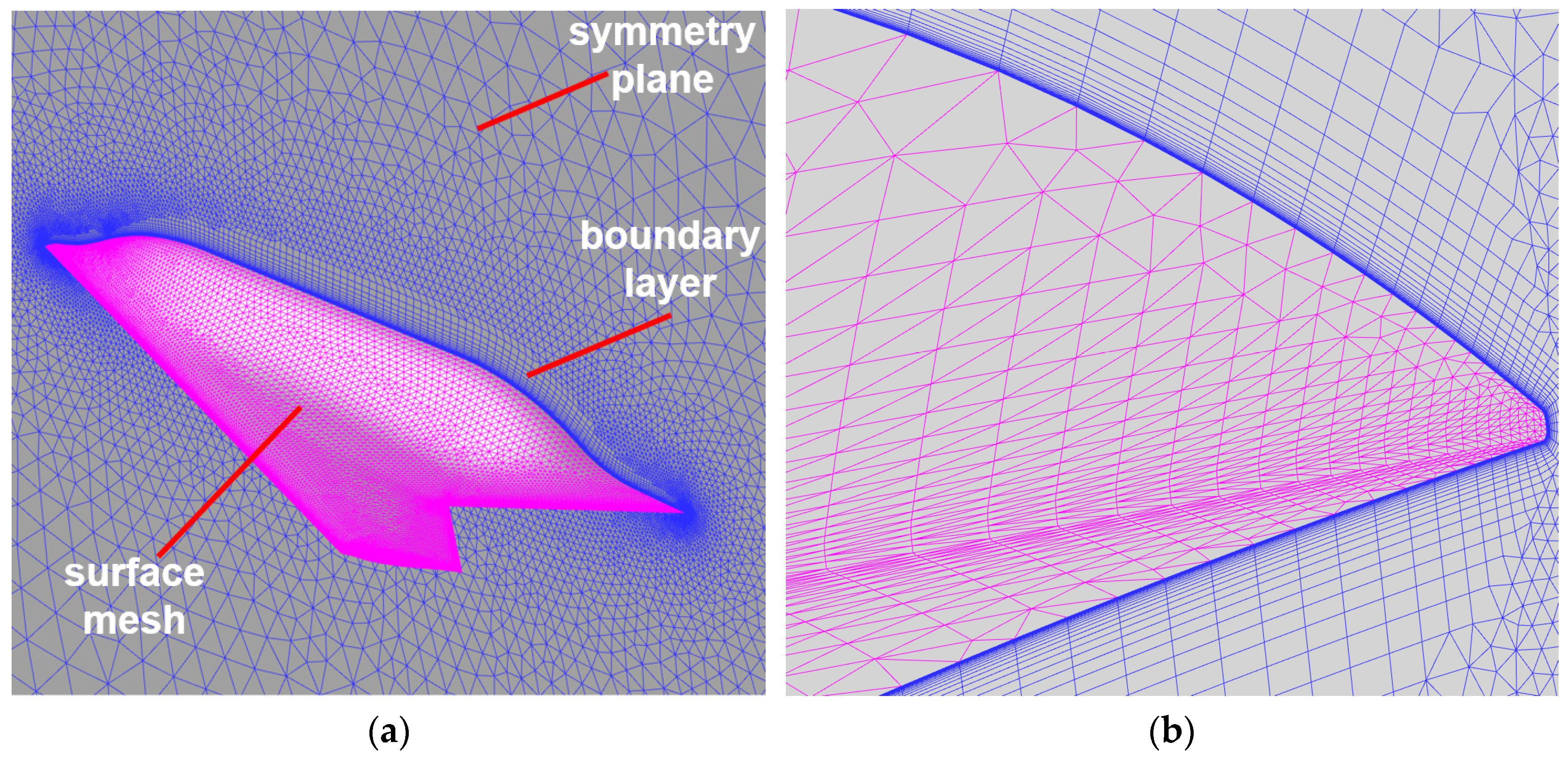
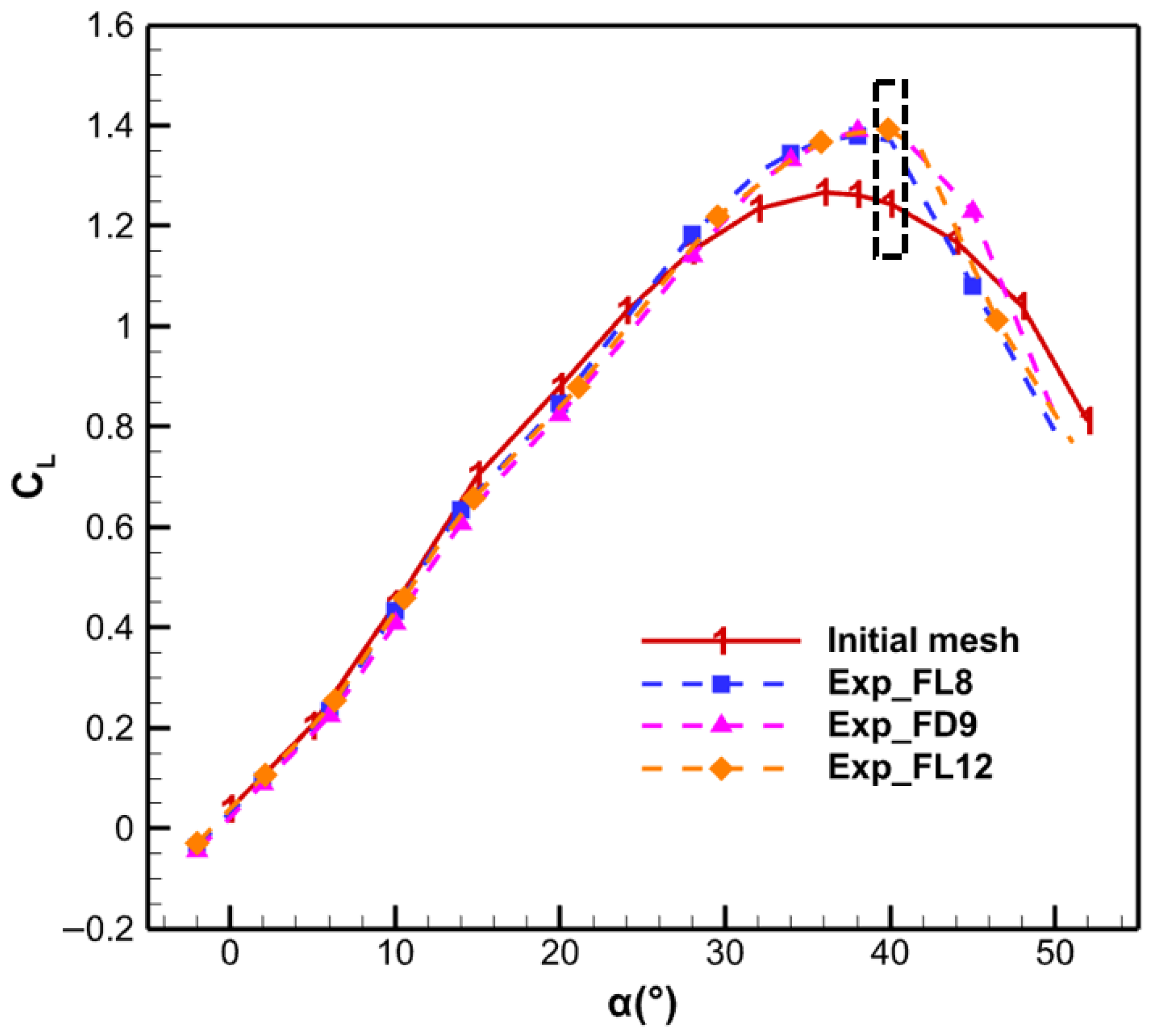
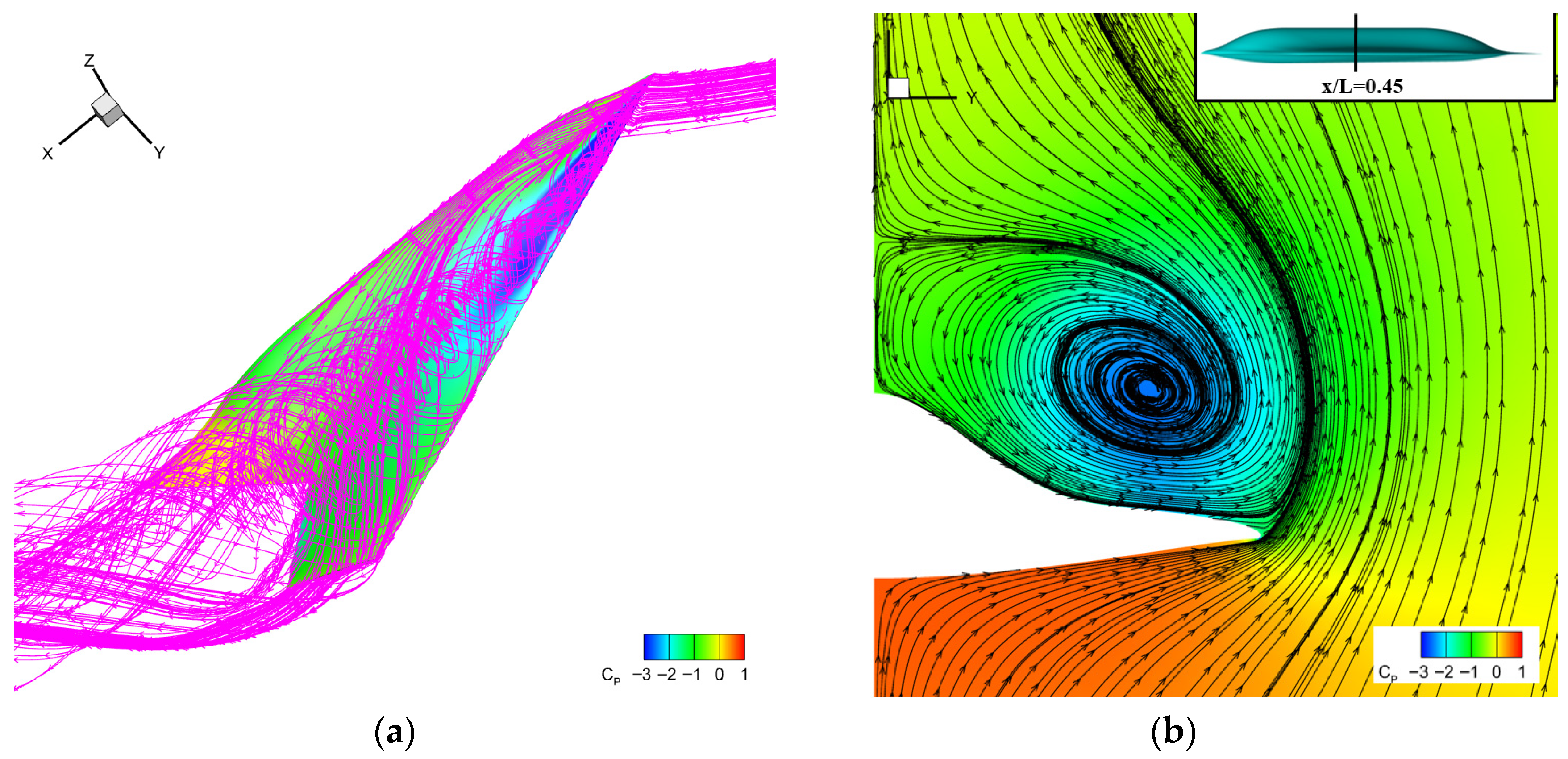
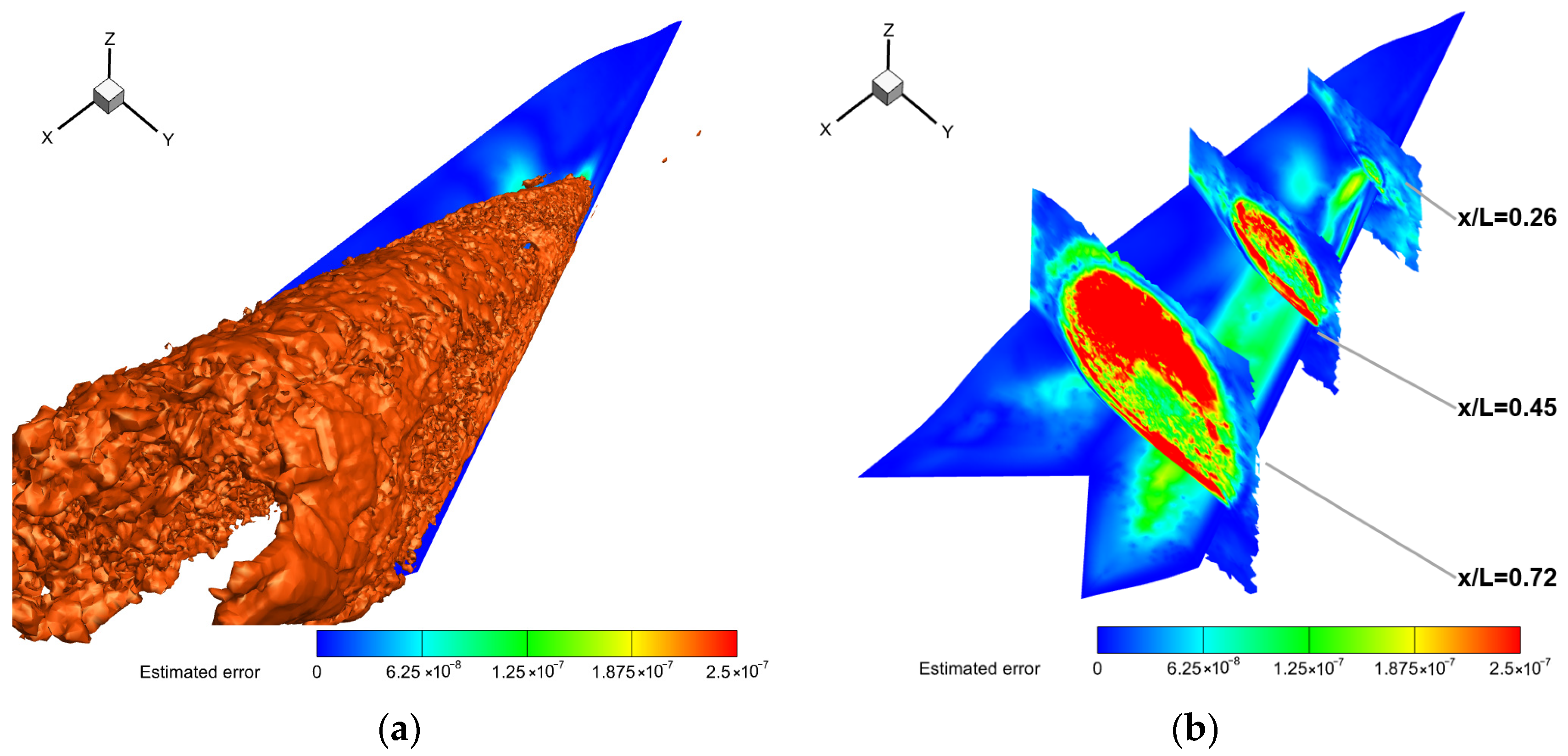
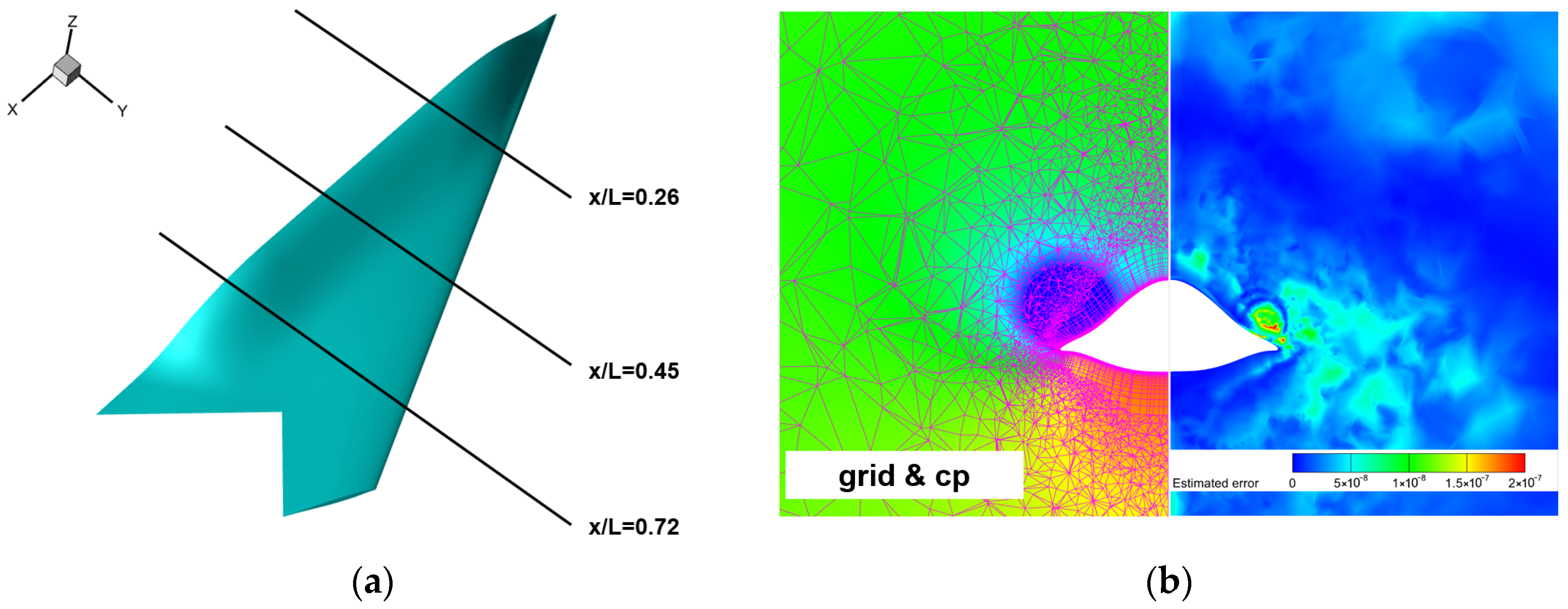
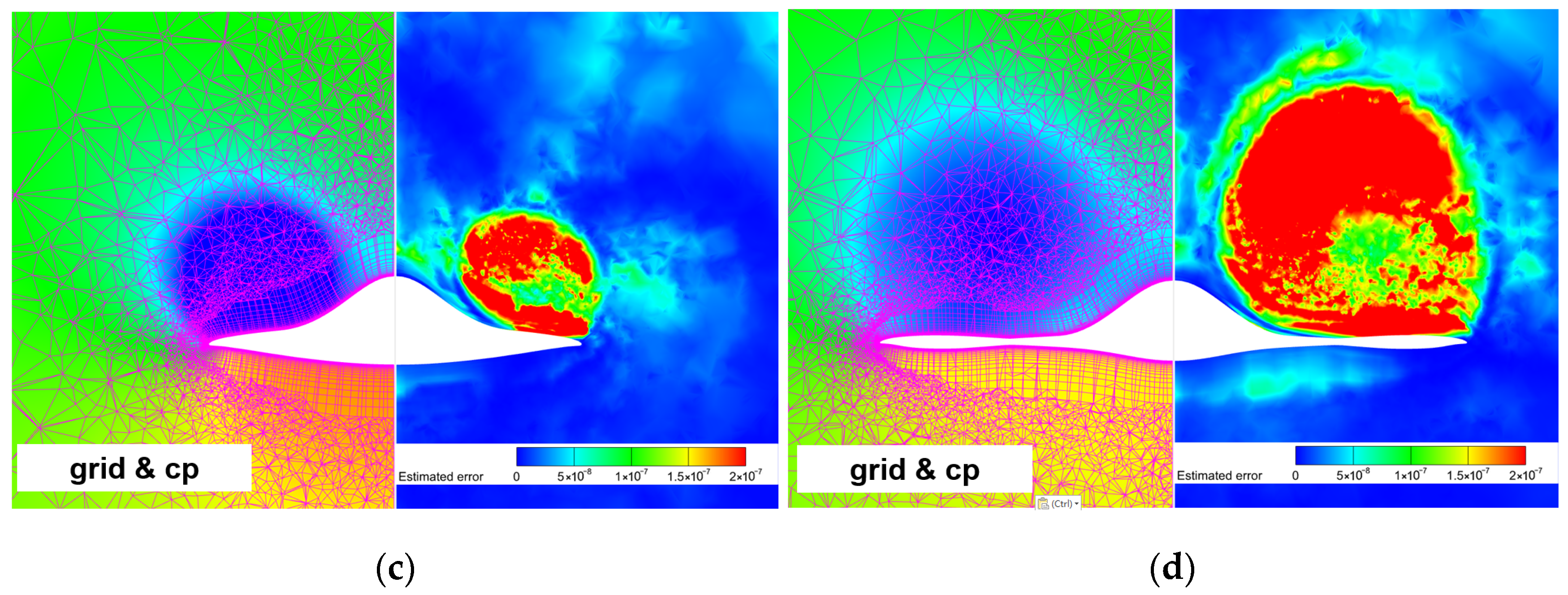

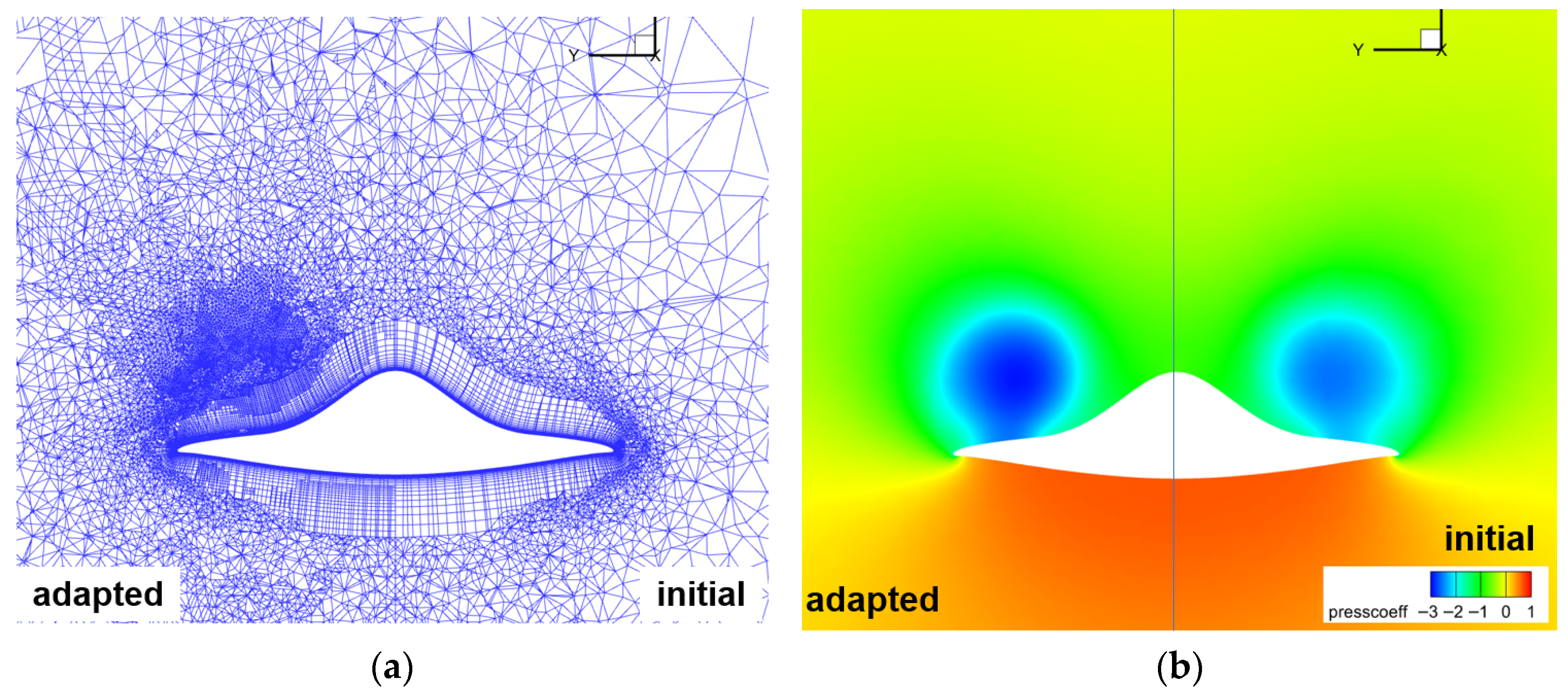


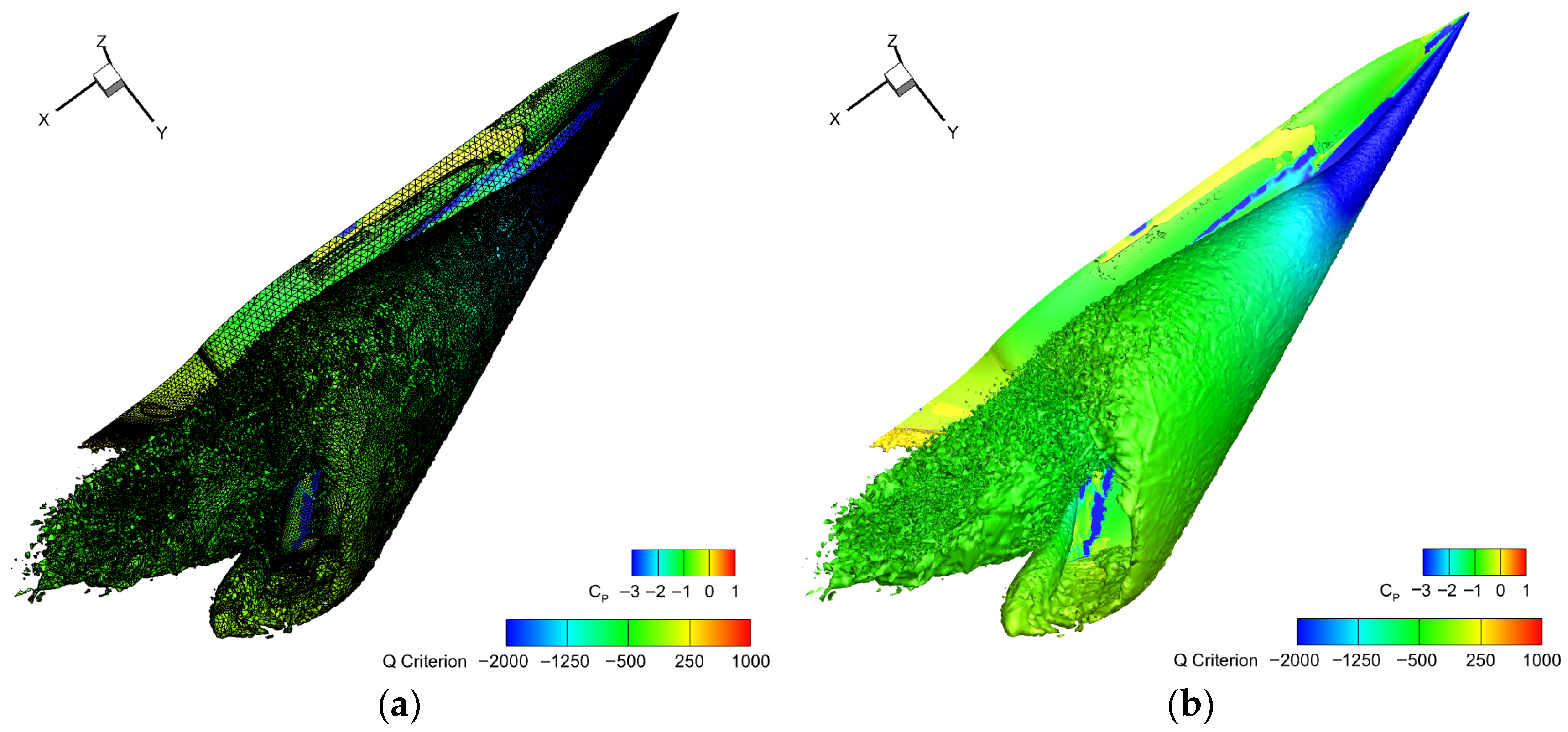
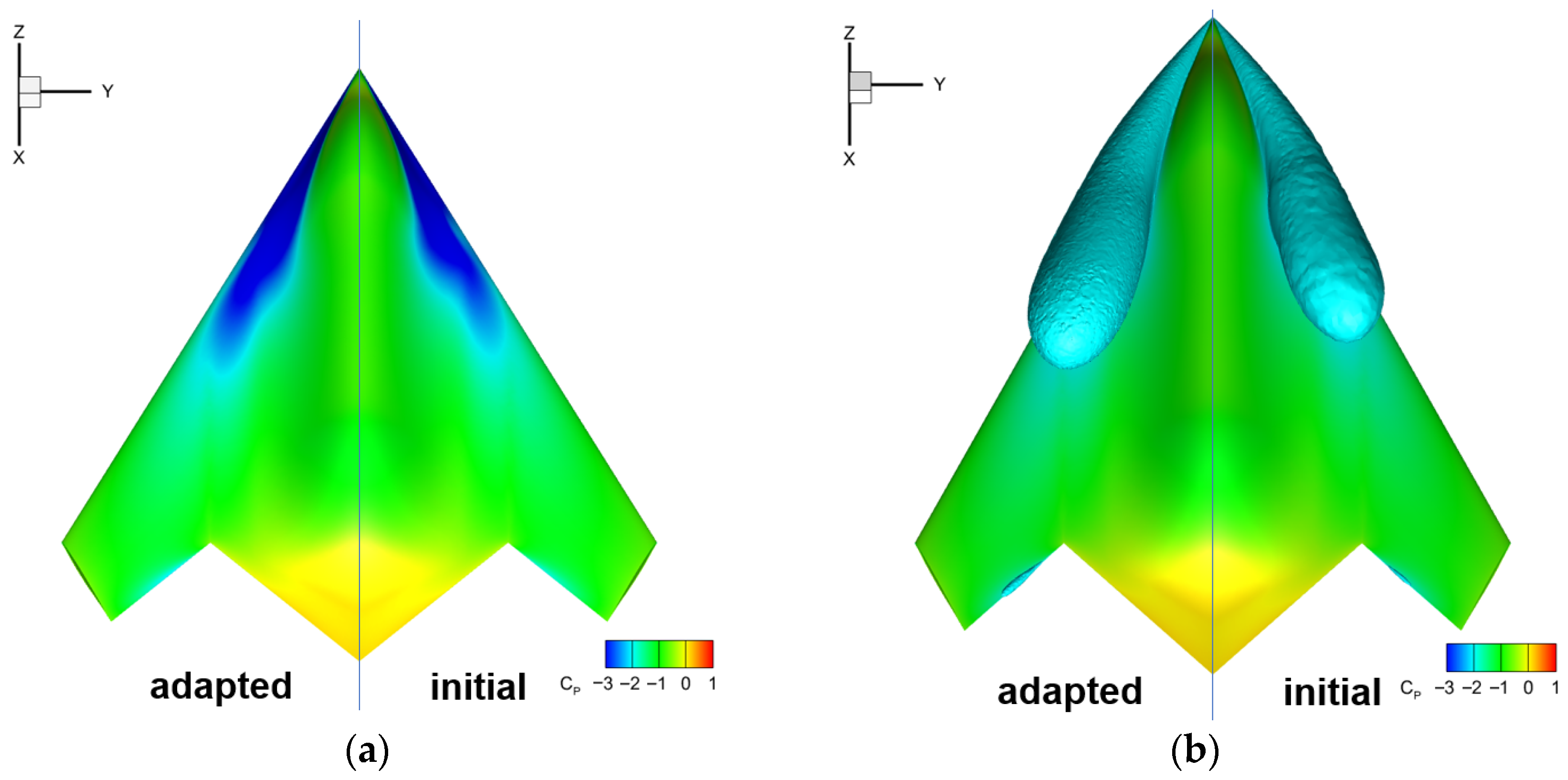
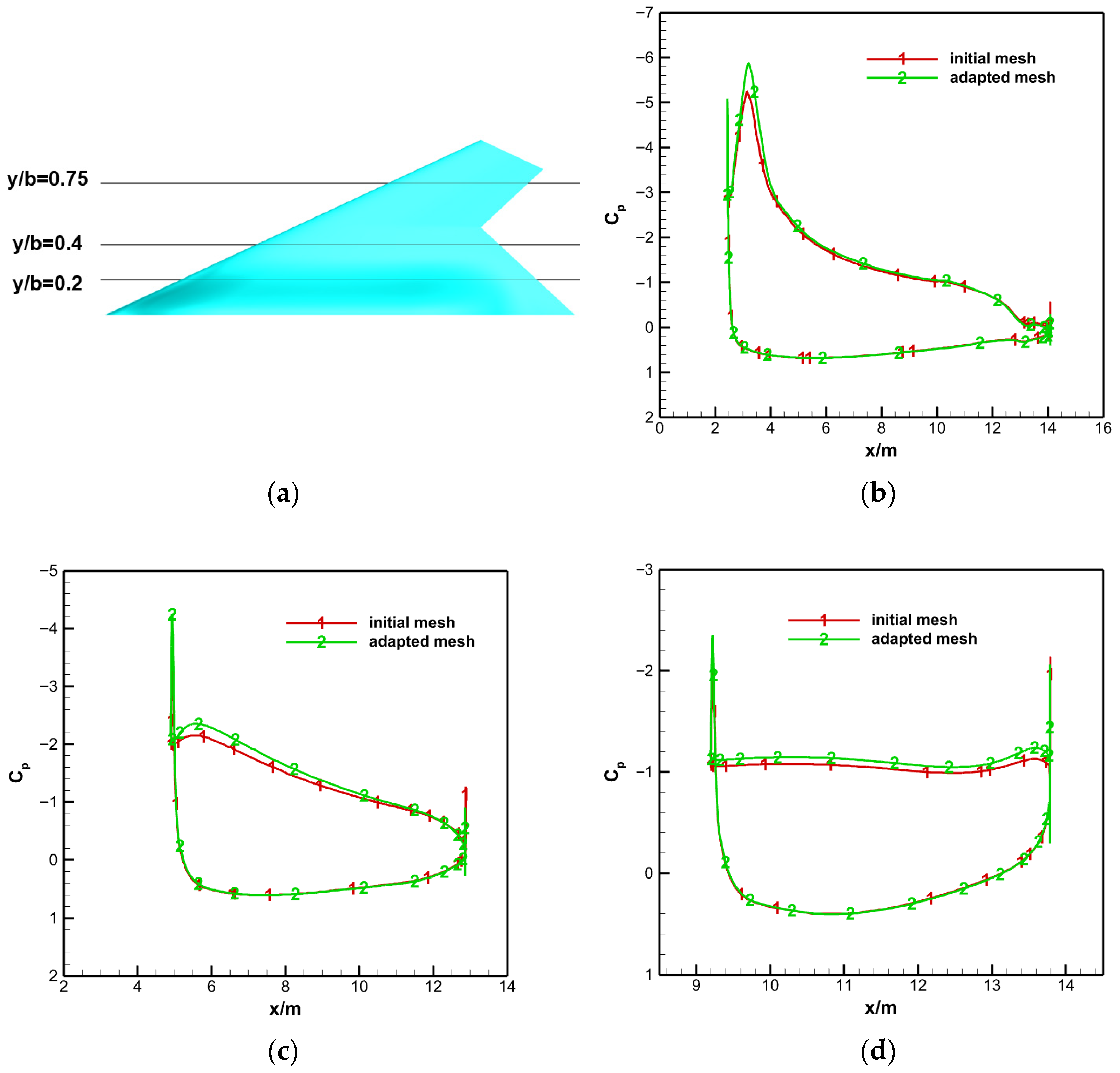

| Parameter | Value/Type | Parameter | Value/Type |
|---|---|---|---|
| Mach number (Ma) | 0.15 | Angle of attack (α/°) | 5~18 |
| Sideslip angle (β/°) | 0 | Numerical scheme | HLLE++ |
| Static temperature (K) | 300.0 | Static pressure (Pa) | 1.831 × 105 |
| Turbulence model | SA | Size of computational domain | 50 times chord lengths |
| Grid type | Unstructured hybrid | Grid size (2D) | 16,913 |
| Flow solver | NNW-FlowStar | Unit Reynolds number | 6.0 × 106 |
| Parameter | Value | Parameter | Value |
|---|---|---|---|
| Leading edge sweep angle (°) | 65 | Trailing edge sweep angle (°) | 47 |
| Wingspan (m) | 11.43 | Aspect ratio | 1.54 |
| Fuselage length (m) | 15.32 | Reference center of gravity | 0.45 |
| Reference length (m) | 9.56 | Reference area (m2) | 84.6 |
| Flow solver | NNW-FlowStar | Unit Reynolds number | 4.7 × 106 |
| Parameter | Value/Type | Parameter | Value/Type |
|---|---|---|---|
| Mach number (Ma) | 0.2 | Angle of attack (α/°) | 0~52 |
| Sideslip angle (β/°) | 0 | Numerical scheme | HLLE++ |
| Static temperature (K) | 288.15 | Static pressure (Pa) | 1.013 × 105 |
| Turbulence model | SST | Size of computational domain | about 50 times fuselage length |
| Grid type | Unstructured hybrid | Grid size (half) | 3.65 million |
Disclaimer/Publisher’s Note: The statements, opinions and data contained in all publications are solely those of the individual author(s) and contributor(s) and not of MDPI and/or the editor(s). MDPI and/or the editor(s) disclaim responsibility for any injury to people or property resulting from any ideas, methods, instructions or products referred to in the content. |
© 2025 by the authors. Licensee MDPI, Basel, Switzerland. This article is an open access article distributed under the terms and conditions of the Creative Commons Attribution (CC BY) license (https://creativecommons.org/licenses/by/4.0/).
Share and Cite
Cui, P.; Wu, X.; Chen, J.; Jia, H.; Qin, F.; Zhang, J.; Zhang, Y.; Zhou, G.; Tang, J. A Viscous Boundary Layer Mesh Adaptation Method and Its Application in High-Angle-of-Attack Separated Flows. Appl. Sci. 2025, 15, 11615. https://doi.org/10.3390/app152111615
Cui P, Wu X, Chen J, Jia H, Qin F, Zhang J, Zhang Y, Zhou G, Tang J. A Viscous Boundary Layer Mesh Adaptation Method and Its Application in High-Angle-of-Attack Separated Flows. Applied Sciences. 2025; 15(21):11615. https://doi.org/10.3390/app152111615
Chicago/Turabian StyleCui, Pengcheng, Xiaojun Wu, Jiangtao Chen, Hongyin Jia, Fan Qin, Jie Zhang, Yaobing Zhang, Guiyu Zhou, and Jing Tang. 2025. "A Viscous Boundary Layer Mesh Adaptation Method and Its Application in High-Angle-of-Attack Separated Flows" Applied Sciences 15, no. 21: 11615. https://doi.org/10.3390/app152111615
APA StyleCui, P., Wu, X., Chen, J., Jia, H., Qin, F., Zhang, J., Zhang, Y., Zhou, G., & Tang, J. (2025). A Viscous Boundary Layer Mesh Adaptation Method and Its Application in High-Angle-of-Attack Separated Flows. Applied Sciences, 15(21), 11615. https://doi.org/10.3390/app152111615




